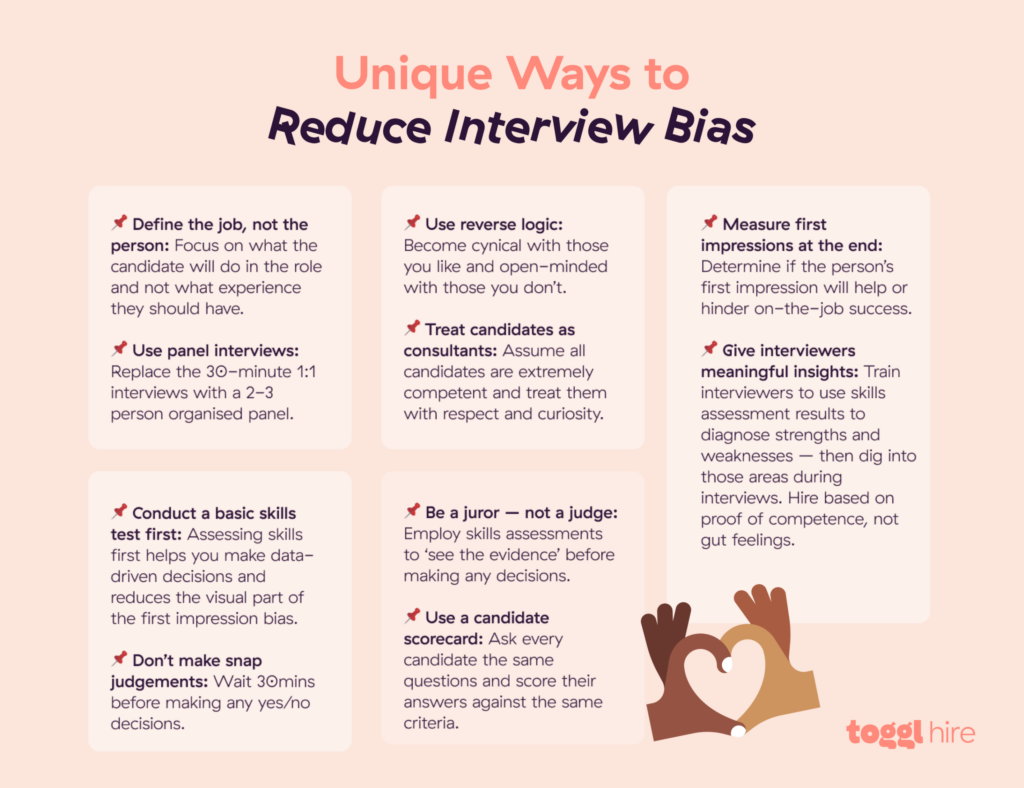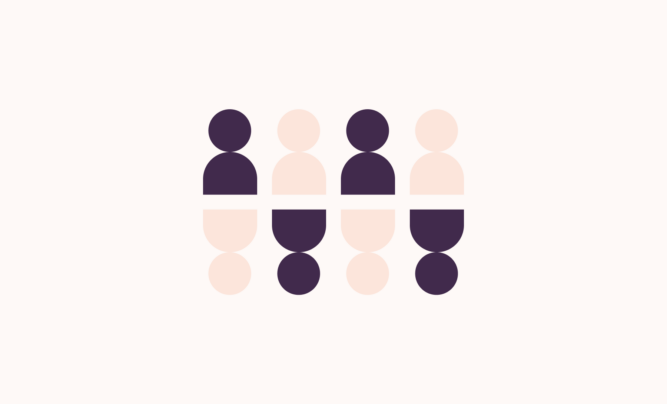Have you ever met someone you had a lot in common with and felt instantly connected? That’s similarity bias — the effect of a shared background, interests, looks, or experiences positively influencing your perception of a person when it might not be entirely justified.
While this can be a great advantage in frivolous social settings, it’s not usually the best measure of a person’s personality or skills in a professional setting. A hiring process riddled with similarity bias leads to companies with very low diversity.
And as you’re about to see, a lack of diversity has a knock-on effect on company creativity, growth, innovation, and employee satisfaction…
TL;DR — Key Takeaways
Similarity bias, or affinity bias, is the phenomenon of preferring individuals whom we see as similar to ourselves in some way.
Similarity bias in the hiring process is dangerous as it can lead to preferential treatment of certain types of candidates and create an unfair recruitment process.
Continuously perpetuating the similar-to-me effect over time leads to reduced company diversity, a culture of conformity, and one-dimensional thinking and problem-solving.
Introducing measures like screening candidates with skills tests, anonymous or diverse panel interviews, inclusive job descriptions, and regular unconscious bias training can go a long way to reduce all kinds of unconscious biases, including similarity bias.
What is similarity bias?
Similarity bias — also known as similar-to-me bias or affinity bias — is when you’re drawn to people you see as similar to yourself. Humans naturally and unconsciously create an “in group” and an “out group” based on who we think has the same interests, experiences, the same background, or even the same ethnicity as us.
This is an example of a cognitive bias, along with the horn and the halo effects. It’s one of many mental shortcuts our brains devise to help us make decisions in an age of information overload. Unfortunately, these shortcuts, while often subconscious, are far from harmless. Instead, they’re often the foundation of all kinds of discrimination, especially racial and gender.

In fact, when similarity bias manifests in the hiring process, it can be deeply problematic. It can subtly influence your hiring decisions, lead you to give preferential treatment to similar people to yourself and overlook other qualified candidates.
The overall impact on your organization, beyond just unfair hiring, is a less diverse talent and less effective workforce.
What factors into similar-to-me bias?
The similar-to-me effect is based on first impressions.
It takes root when we perceive someone as having lots in common with us, whether that’s because we share a cultural background, hobbies, or jobs, are of the same gender, or have a similar educational background. We even favor people who look similar to us!
Naturally, having lots in common with someone at the outset can be a great basis for easy and frictionless small talk, but it is not a good basis for important hiring decisions.
Similarity bias examples in hiring
The similar-to-me bias manifests in hiring in a few different ways. Some of the most common examples include:
Giving preferential treatment to someone because they went to the same university as the hiring manager
Discovering a candidate is from your own culture and immediately letting that (unconsciously!) cloud your judgment
Not giving candidates an equal chance once you find out your latest interviewee shares the same hobbies as you
Again, while natural and often very subconscious, you’re likely starting to see the issue with letting this kind of unconscious hiring bias creep into the process. Aside from going against fair hiring practices, it can lead to poor hiring decisions and resentment among true top performers.

How does similarity bias affect the hiring process?
There are several different kinds of bias that exist, and they all affect the hiring process in their own ways. That’s why it’s so important to be aware of them and educate yourself, your hiring teams, and any other relevant decision-makers as much as possible.
Similarity bias, in particular, is a silent enemy, as it can affect various important factors that lead to diversity and innovation in your organization.
Limits diversity
By favoring people similar to yourself or other employees in your team, you unintentionally limit diversity. If your subconscious focus is on similar-looking individuals, you’re missing out on a whole pool of talent, backgrounds, and perspectives that will enrich the team.
One survey by Builtin found that diverse companies are 70% more likely to capture new markets, underscoring the innovative potential that a varied team can bring.
A lack of diversity resulting from similarity bias doesn’t only affect the company’s bottom line, though — it also influences its attractiveness as an employer. A LinkedIn Learning report highlighted that 76% of employees and job seekers said diversity was important when considering job offers.
This suggests that businesses failing to address the similar-to-me effect in their hiring practices risk not only missing out on the benefits of a diverse workforce but also potentially losing top talent to more inclusive competitors.

Hurts innovation
The similar-to-me bias naturally leads to less diverse employees, and it’s well-documented that this stifles growth and innovation. A McKinsey report found that more diverse teams are more creative, better at problem-solving, and generate more revenue than their homogenous counterparts.
As mentioned above, if your company is filled with the same type of person, you get similarly-minded people with all the same opinions. While that’s great if you’re looking for agreement, it’s horrible from a business perspective as it leads to stagnation and uninspired employees.
Yet, if you introduce diversity, you introduce new people from a range of backgrounds with their own opinions and perspectives. Diverse teams are able to look at problems from various angles, relying on unique experiences to solve them faster.
Influences decision-making
Similarity bias significantly affects hiring fairness, often leading to decisions based on personal similarity rather than actual qualifications (something we care about and talk a lot about here at Toggl Hire).
It’s a big reason why we support structured interviews as a way to reduce falling prey to the similar-to-me effect. They ensure evaluations are based on consistent criteria rather than subjective impressions, like whether the candidate is of your own gender, shares a similar physical appearance, or engages in small talk about your shared love for a college basketball team.
And there’s data to back up the idea that working to reduce similarity or experience bias that leads you to favor people similar to you leads to better hiring outcomes. McKinsey notes that hiring for skills is 5x more predictive of job performance than hiring for other factors like education.
Undermines inclusion efforts
Finally, similarity bias can undermine efforts to create an inclusive workplace. Picture a workplace where everyone nods along, mirroring each other like synchronized swimmers in a corporate pool. Sounds harmonious? Maybe. Inspiring? Hardly.
When new hires feel they need to morph into carbon copies of their colleagues to fit in, we’re not exactly championing authenticity. Instead of a vibrant tapestry of ideas, we end up with a bland, monochrome working environment that stifles creativity and innovation.
While that’s worrying from a business perspective, it’s also a surefire way to alienate top talent these days. According to Deloitte, 83% of millennials are actively engaged when they believe their organization fosters an inclusive culture. That’s a whopping majority craving genuine inclusion.
8 ways to avoid similarity bias in hiring
Understanding how similarity bias manifests and how it impacts individual decision-making and wider workplace culture is the first step toward reducing it.
Don’t worry if you can’t seem to shake the bias immediately — this work is an ongoing process, and it won’t happen overnight. Instead, the goal is to take actionable steps to avoid similarity bias, mitigate its effects, and keep your hiring process as fair as possible.
Whether you’re hiring for managerial positions or entry-level roles, here are a few tips for avoiding creating a workforce full of “similar to us” employees and instead building a diverse team.

1. Create inclusive job descriptions
Job descriptions that are free from gender bias or any other exclusionary language are more inviting and appealing to diverse candidates. Being intentionally inclusive in your word choice has a direct impact on the talent pool that will apply to your listing.
Consider the weight your word choice carries. For example, words like “hard-driving” and “competitive” are generally associated with masculinity, while words like “collaborative” and “supportive” have more feminine associations.
2. Use skills tests to assess candidates
Skills tests are excellent tools to objectively evaluate a candidate’s ability. They reduce reliance on other kinds of assessments that can be influenced by similarity bias.
Implementing a skills test at the beginning of the hiring process is a great place to start, allowing you to instantly filter out 80-90% of candidates based completely on their competence and nothing else. Regardless of where you plug it into your hiring process, they’re sure to help reduce similar-to-me bias.
3. Anonymize candidate profiles
Similarly to skills tests, anonymized candidate profiles in your ATS help mitigate similarity bias by focusing solely on candidate skills and experiences. They eliminate personal traits, backgrounds, and anything else from applications that might trigger a bias.
One way to try this could be through audio-only interviews or tools that help you anonymize applications to get rid of information associated with age, race, gender, sexual orientation, ability, and more. If you’re feeling super avant-garde, you could use an AI avatar.
4. Hire for culture add, not culture fit
We hear so much about hiring for “culture fit,” but a more constructive way to think about this is to hire for “culture add” instead.
This ties in with the inclusion piece and fostering an environment where employees feel safe to shine for who they are, not who the workplace culture (especially if it is full of similar people!) expects them to be.
5. Offer unconscious bias training
Unconscious bias training is great for combating all kinds of cognitive biases. These trainings are used to bring awareness to these biases and how to mitigate them. But don’t treat this as something to check off a recruitment team to-do list!
Dedication to this matter should be ongoing and ever-evolving to ensure the teachings become ingrained within the fabric of the company’s value system and bleed through to every area of business.
6. Build diverse interview panels
Another easy place to introduce a similarity bias counterattack is during the interview stage. Including a diverse interview panel helps cancel out the similar-to-me bias any individual interviewer might have.
The richness of varying perspectives helps hiring teams come to more objective conclusions about who the best candidate for a job would be.
Not only that, but it shows candidates themselves that your team is full of people from different backgrounds and that you don’t tend to surround yourself with or prefer people who look exactly like you do.

7. Conduct structured interviews
Structured interviews with standardized questions can help keep candidate evaluations objective, as they’re all being judged against the same criteria. This reduces the influence of similarity bias and the tendency to be swayed by someone who seems to be in our “in group.”
This is in contrast to an unstructured interview, which is more like a spontaneous conversation. This kind of interview might be best if you’re looking to fill a jack-of-all-trades role or if you’re a very small startup where structured interviews might be unnecessarily time-consuming to put together.
8. Promote workplace diversity
Promoting workplace diversity beyond just hiring decisions is key to it becoming a part of company culture. Celebrating differences as things that make us smarter and stronger is a great way to combat similarity bias.
Embodying those values is what creates a more inclusive work environment where employees of all backgrounds feel safe to bring their full selves to work. Usually, a person’s full self is their best self!
Avoid affinity bias with Toggl Hire
Similarity bias, also known as similar-to-me bias or affinity bias, is the prejudice of favoring people who are “similar to me,” whether that’s because they are of the same gender, cultural or educational background, look like you, or share the same interests as you.
The similar-to-me effect can occur at any point in the recruitment process and seep all the way to the roots of your company culture and organizational behavior. It is super detrimental to diversity and inclusion efforts and can negatively impact your company’s overall innovation, creativity, and bottom line.
There are tools to help you avoid this kind of bias, though. Skills tests like Toggl Hire can help you avoid cognitive biases like similarity bias by evaluating candidates based purely on objective competence and nothing more. Create a free account to see how it works!

Julia is a freelance writer and fierce remote work advocate. While traveling full-time, she writes about the intersection of technology and productivity, the future of work, and more. Outside work, you can find her hiking, dancing, or reading in a coffee shop.






